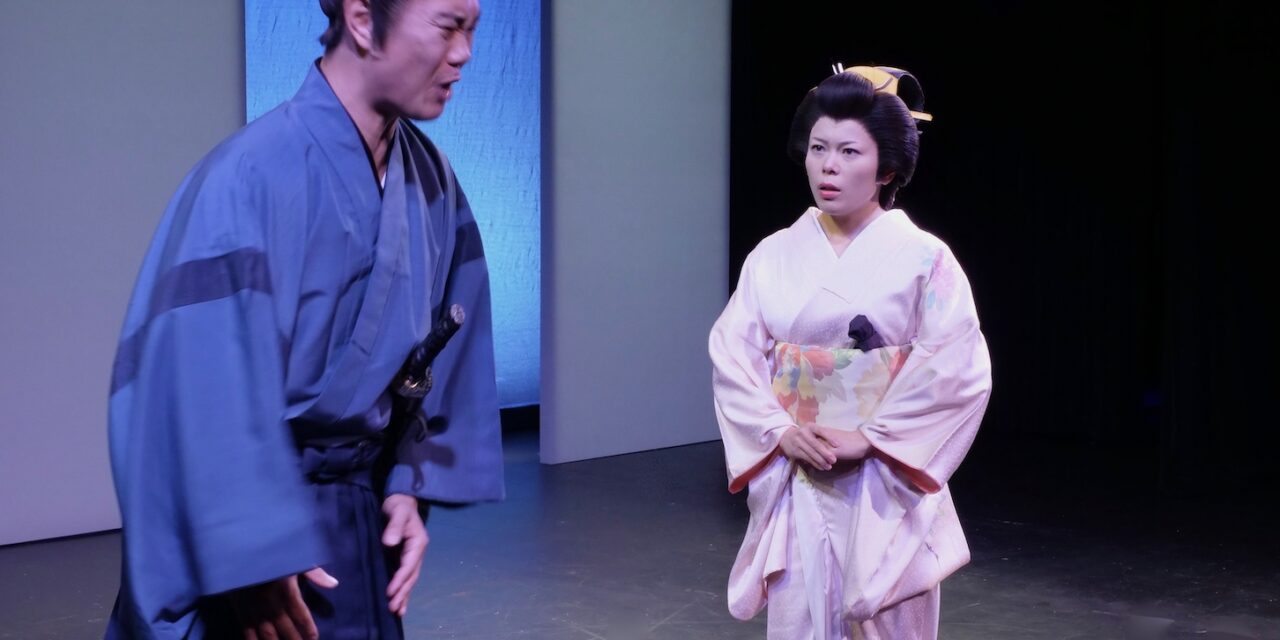By Samuel L. Leiter . . .
With Chushingura—47 Ronin, Ako Dachs, a respected New York actress born and bred in Japan (where she was a Takarazuka member!) has undertaken a unique but awesome task with her Amaterasu-za company. This is the dramatization for an American audience of the most culturally pervasive of Japanese revenge stories, what is generally known in Japan as the Akō Vendetta (or Incident). As portrayed in the theater, the vendetta’s generic name would be Chūshingura, translated variously, including The Treasury of Loyal Retainers and The Story of the 47 Ronin. Ms. Dachs is to be commended for her valiant attempt, although the outcome is somewhat less than a success.
What makes her production especially unusual is that her entirely Japanese cast of nine performs in Japanese, supertitles providing the English equivalents. Despite a number of spelling and grammatical errors, they are easy to read; more problematic is their sometimes lack of synchronization with the words being spoken. English is used only by the narrator (Ms. Dachs), as explained below.
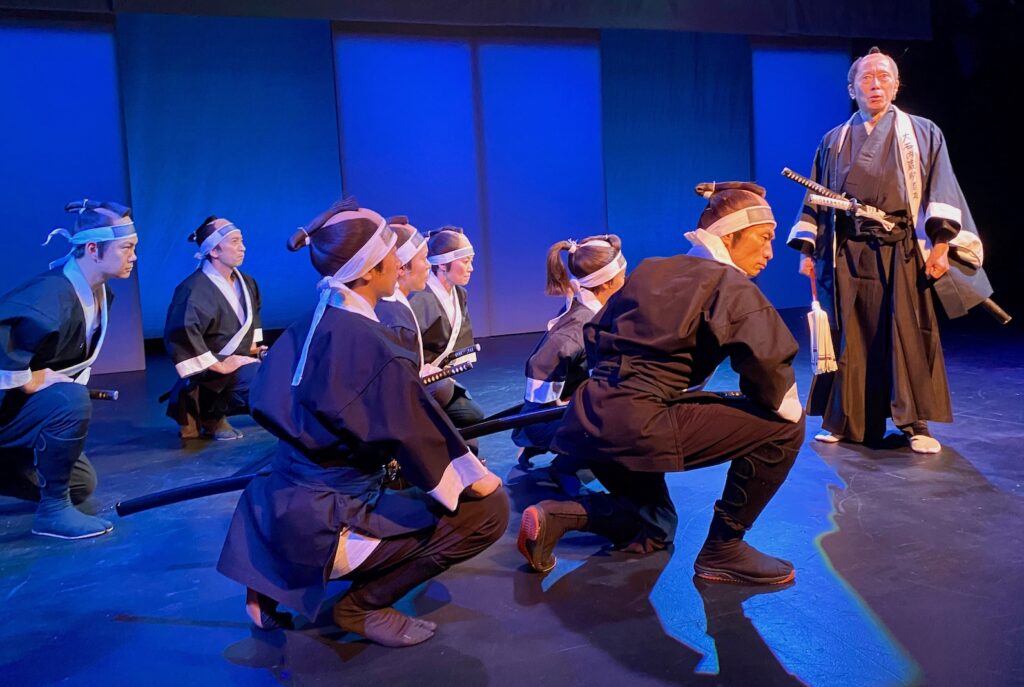
Here’s the background: in 1701 (Ms. Dachs’s script says 1702) Asano Takuminokami, lord of Akō Castle, was at the shogun’s castle in Edo seeking advice on ceremonial matters for an important event. The shogunate advisor, Kira Kōzukenosuke, annoyed at having not been properly bribed, so abused Asano that he drew his sword and wounded Kira, but was stopped before he could kill him. The very act of Asano having drawn his sword in those precincts was enough for him to be sentenced to death, albeit by the honorable method of seppuku. His family was dispossessed of its property and his line extinguished. In retaliation, 47 of Asano’s most faithful retainers, led by his steward, Ōishi Kuranosuke, secretly plotted their revenge. Ōishi even pretended to have fallen into dissipation to avoid suspicion. On a snowy night in 1703, the faithful 47 broke into Kira’s mansion and beheaded their enemy, for which they were all forced to commit seppuku. Instantly, they became martyrs beloved by the Japanese people, who even today burn incense at their graves at Sengakuji Temple in Tokyo.
A considerable number of Japanese plays—the great classic being the epic, 11-act Kanadehon Chūshingura (1746), first done by the puppet theater and quickly adapted by kabuki—are based on actual vendettas, like that of the Soga brothers. No revenge story, however, has as much of a grip on the Japanese soul as this one, which happened at a time when the available media, including the theater, were able to make it widely known. When dramatized, however, censorship restrictions required it be set in the distant past and the names of the participants changed. Lord Asano (Yasu Suzuki) was renamed Enya Hangan, Ōishi Kuranosuke (Tatsuo Ichikawa) became Ōboshi Yuranosuke, and Kira Kōzukenosuke (Hiroko Yonekura) turned into Kōno Moronao, each a classic theatrical role.
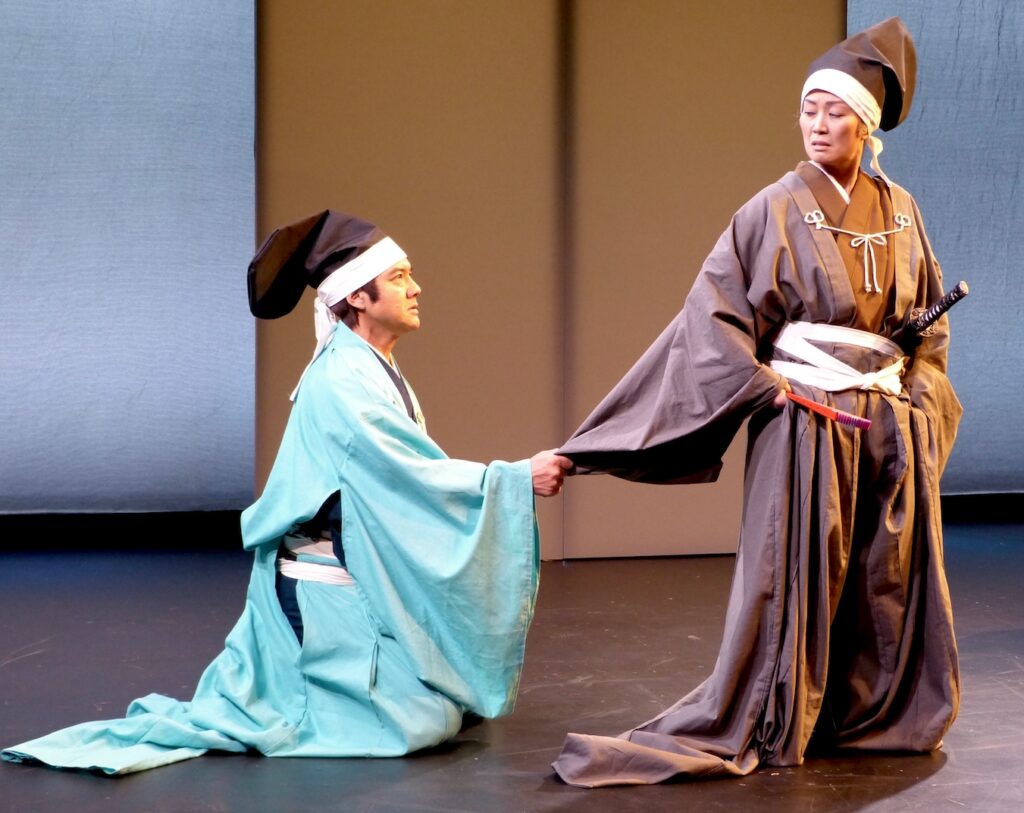

So rooted in Japanese social conventions is the story of the 47 masterless samurai that Life magazine published a well-illustrated essay on it during World War II as a warning about the dangers such avidity for vengeance held for the Allies. There’s actually a small body of scholarship, including a couple of my own books—The Man Who Saved Kabuki: Faubion Bowers and Theatre Censorship in Occupied Japan and Rising from the Flames: The Rebirth of Theatre in Occupied Japan—on how postwar American censorship kept Chūshingura off the stage for two years because of its feared potential for provoking violence against the occupying forces.
There are so many stage versions of the Chūshingura story that they form a subgenre of their own, while the number of Chūshingura movies and TV shows is well up in the hundreds. In the late nineteenth century, a trend began of dramatizing the story by removing the more fictionalized parts of the plays, including the tragic love affair of would-be avenger Hayano Kanpei and Okaru, and hewing closer to the historical events. The classic example is Mayama Seika’s ten-play cycle, Genroku Chūshingura (1934-1941), which may, perhaps, have inspired Ms. Dachs’s much shorter version, which, it must be understood, is not based on the kabuki or bunraku renderings. (A full translation of Mayama’s play is forthcoming from Paul Morris Griffith, Ronald Cavaye, and Brian Powell.)
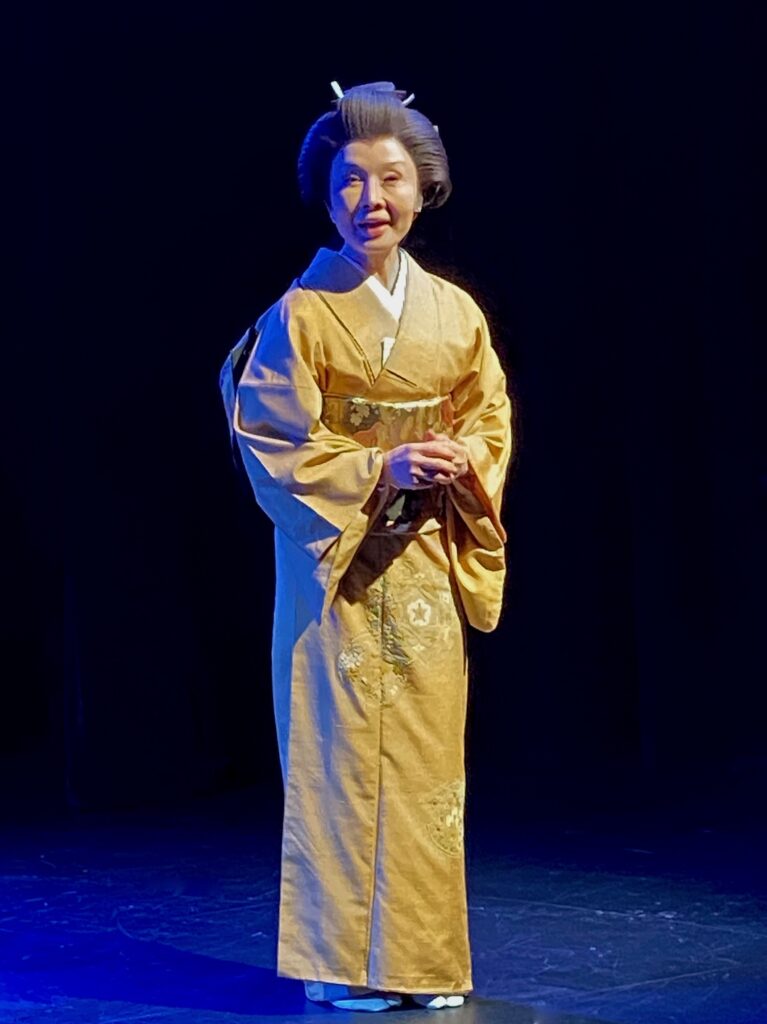

To compress the massive amount of information into two hours, Ms. Dachs relies on a narrator, which she herself plays, to periodically interrupt the action and fill in the background information. Her name is Riku, wife of Ōishi Kuranosuke, who also appears as such in the play proper when necessary. These interpolations, while delivered by Ms. Dachs in the sweet, soft-voiced manner of a traditional Japanese woman, are among the obstacles to making her play dramatically dynamic, as they slow the action down in favor of exposition when action is required.
By and large, the play, tending toward talkiness, lacks the tension and romantic color of its traditional forebears. The excellent costumes (smartly designed by Ms. Dachs on what was probably a limited budget) and the expert wigs of Mitsuteru Okuyama give the show a feeling of authenticity—although one wonders if a lack of access to them prevents most of the samurai from carrying both a long and short sword.
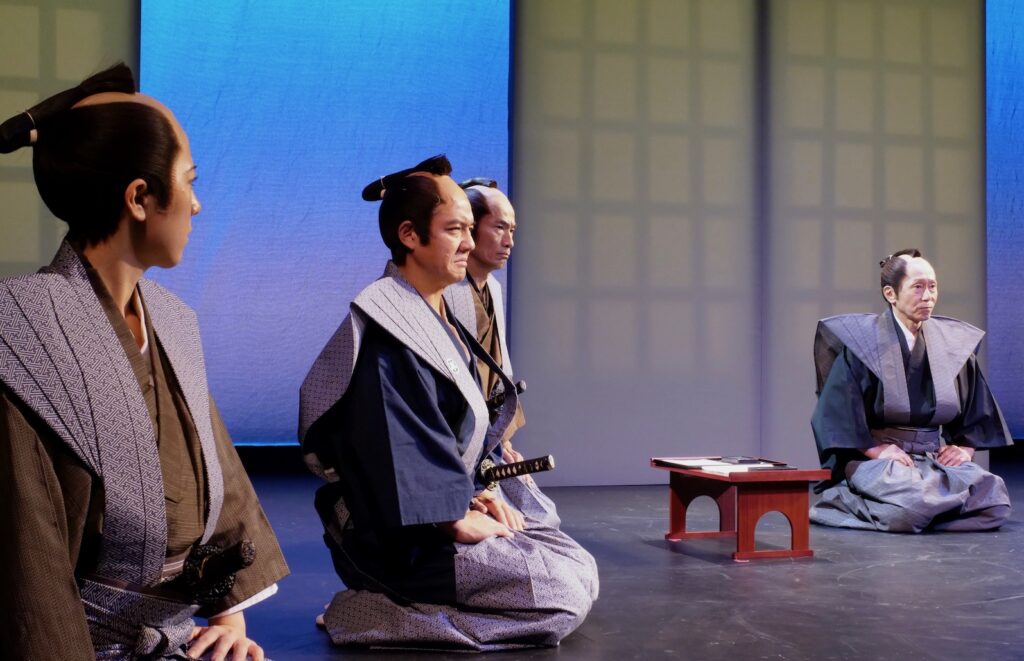

Also deserving praise is Ms. Dachs’s staging, which captures the sit-on-your-knees ambience of premodern, highly formalized Japanese behavior. Further worthy of respect is the cast’s ability to emulate the acting style used in Japanese period movies, even with several actresses playing both male and female roles. The cross-dressed casting works most of the time, but having a slim young woman play the evil Kira is a serious mistake. (Happily, none of the men is asked to serve in drag as an onnagata.) Still, because the cast must double, and even triple, it’s sometimes hard to determine who is who, leading to occasional character confusion.
Where the play comes most vividly to life is during the admirably staged and executed combat scene (or tachimawari) of the assault on Kira’s mansion, created by Kyo Kasumi. The expertly designed sequence of slashing swords and graceful athletic movements almost justifies the less effective discursive scenes that precede it. A number of such scenes, which might have introduced commanding dramatic qualities, dry up before they achieve such goals.
Take, for example, the one in which Kira insults Asano to the point where the latter strikes out, which is too brief to establish Kira’s cruelty—so forcefully expressed in kabuki—where you want to draw your own sword and attack the bastard. Another is Asano’s seppuku scene, which ends before he ever does the deed; in conventional productions it never fails to draw streams of tears. Once you decide to alter the dramatic highlights of a classic, you have to come up with something comparably effective if you’re not going to end up with a rag doll replacing a living thing.
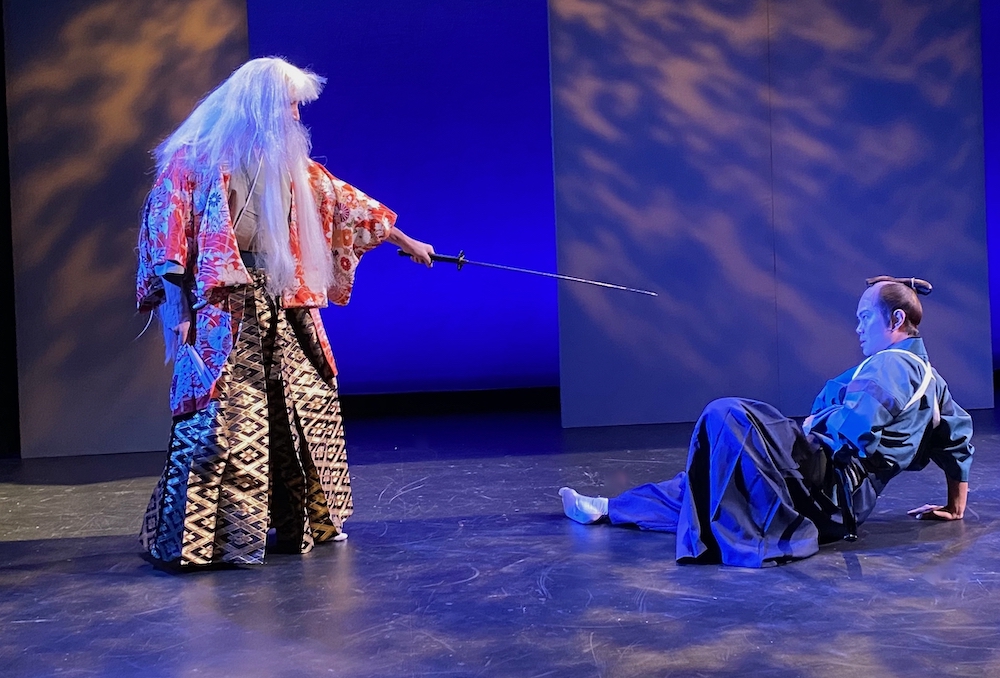

The show also needs much more than the bare minimum of familiar-sounding flute and drum Japanese music it gets (Fumi Tanakadate is the sound designer). This is especially true for those theatrically dull transitions between one scene and the other. The lack of shamisen underscoring is especially concerning, even for a non-kabuki presentation. Aaron Bowersox’s lighting is efficient, if not particularly inventive, but it would be helpful if the small projections (uncredited), shown on a side panel, were replaced by full-scale ones on the bare, upstage panels constituting Joshua Dachs’s simple, non-localized setting.
For all my cavils, a play based on a much-represented, widely known Japanese historical event, performed almost entirely in Japanese by an all-Japanese cast resident in New York, deserves much respect. I must therefore take my eboshi off to the courageous Ako Dachs and her Amaterasu-za company, hoping warmly to see their next encounter with Japanese traditional culture.
Chushingura—47 Ronin. Through November 6 at A.R.T./New York Theatres (502 West 53rd Street, between Tenth and Eleventh Avenues). www.art-newyork.org/show-calendar
Photos: Melinda Hall


